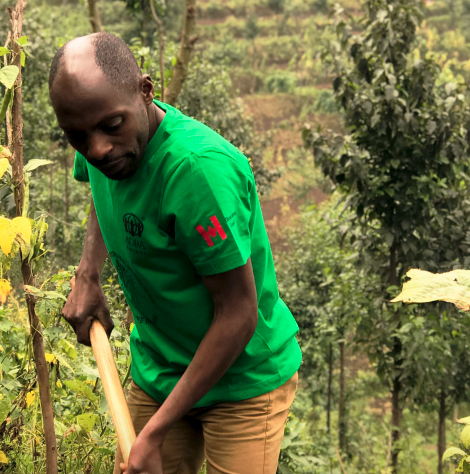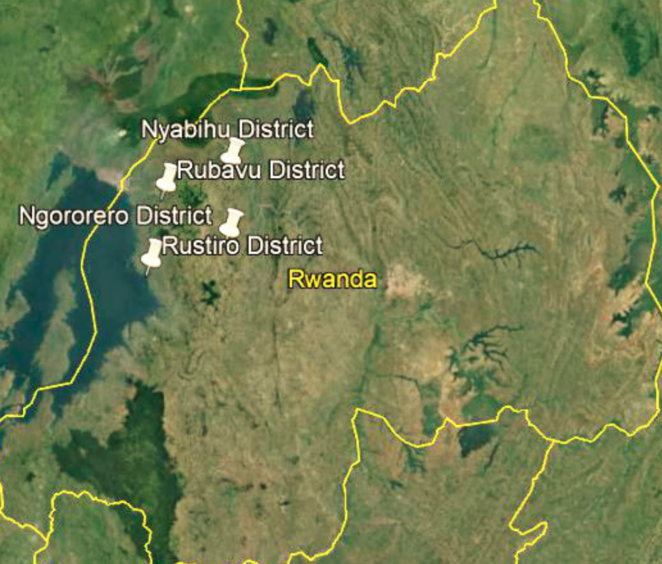Early Warning Climate Forecasting in Rwanda

Introduction
UN Environment is helping the government of Rwanda to build the climate resilience of people living near the Gishwati area. The local population depends hugely on rain-fed crops, but the region is under immense pressure from climate change and erratic rainfall.
The project’s main approaches were to: Build an extensive early warning climate system to help farmers prepare in advance for extreme weather; develop alternative climate-resilient livelihoods like beekeeping; restore over 1,300 hectares of forests to reduce floods and drought; and plant 91,700 fruit trees to enhance food security.

For more information on this case study, please download the pdf from the right-hand column.
Links to SDGs

SDG8: Participants were trained in climate-proof incomegenerating activities, such as poultry and mushroom farming. 185 people were trained in beekeeping. 5 apiaries and 1 honey collection center were built.
SDG13: 22 automatic weather stations were established to help vulnerable communities prepare for oncoming extreme weather events. Around 19,000 people currently subscribe to receive early warnings via SMS.
SDG15: Approximately 1,370 hectares of degraded natural land were regenerated. Around 80,200 bamboo seedlings were planted along 10 km of river path to reduce soil erosion and siltation.
Climate Impacts
- The Gishwati ecosystem sits in the Albertine Rift region and hosts some of the world’s most critically endangered species such as the iconic mountain gorilla.
- The region often experiences heavy rainfall and violent floods, but climate change is increasing their frequency and intensity, leading to deaths, destroyed roads and falling crop yields.
- The unpredictable weather has wrought financial ruin for people that rely solely on farming. Future projections suggest rainfall variability will worsen from 2015-2050, putting the lives of 280,210 people in danger.
- Vulnerability to climate change is worsened by unsustainable resource extraction in the forests, which depletes the ecosystem’s ability to regulate waterflow. The IUCN classified the Gishwati forest as ‘critically endangered.’
When it floods, there are people who lose their lives. We had a long spell of hunger in my household – for four months.” – Alexandre Uhere, farmer in Western Rwanda
Technologies and Methods
- The project established 22 automatic weather stations that distribute live data every five minutes across the country (15 synoptic and 7 hydro-meteorological stations). This early warning system is helping people prepare in advance for extreme weather.
- The warning network has been so successful that Rwanda’s government decided to expand it to increase the number of SMS subscribers from 800 to more than 19,000.
- Farmers have been trained to monitor and utilize rainfall data to inform agricultural activities. A total of 1,254 people and NGOs received training. 60 rain gauges and 30 automatic weather kits were installed in 30 farmers’ cooperatives.
- District Development Plans (DDPs) were climate-proofed in four districts. The main adaptation interventions that were integrated into the DDPs were soil conservation, forestry, rainwater harvesting, and riverbank protection.
- A climate-resilience land-use plan for the vital Gishwati ecosystem was established, dividing lands into settlements, agriculture, and forestry. Approximately 1,373 hectares of degraded land were restored via seedling production and tree planting. Agricultural terraces were built to protect fragile areas from erosion.
- The land rehabilitation endeavor was extended to the protection of 25ha of the Nyamukongoro river watershed upstream of Karago Lake. For this, around 80,200 bamboos seedlings were planted along 10 km of river to reduce soil erosion.
- The project strengthened food security for vulnerable villages by providing 91,700 fruit trees (Tamarillo, Marakuja, Passion fruit and Avocado species)
- Communities were trained in climateresilient livelihoods, such as poultry and mushroom farming. A veterinary pharmacy was established to assist local farming communities with necessary medicines and advice to deal with livestock diseases.
- Climate-resilient beekeeping businesses were established in Gishwati Forest. The project created beekeeping cooperatives and hired an expert to train communities in modern practices, such as ‘swarm multiplication’. 185 members were beneficiaries of these activities. In addition, 5 apiaries were established in five villages, along with a honey collection centre.
Video: Climate Action in Rwanda
From improving weather forecasting to adopting eco-friendly livelihoods, Rwandan communities are working to adapt to the challenges of climate change.
Related resources
- UNEP climate adaptation website
- Guarding against disaster: Rwandan farmers adapt to the changing climate
- Implementing Napa Priority Interventions to Build Resilience in the Most Vulnerable Coastal Zones in Djibouti
- Large Scale Ecosystem-based Adaptation in The Gambia: Developing a Climate-Resilient, Natural Resource-Based Economy
- Enhancing Climate Change Resilience of Rural Communities Living in Protected Areas of Cambodia
- Building Climate Resilience Through Rehabilitated Watersheds, Forests and Adaptive Livelihoods
- Tanzania: Ecosystem-based Adaptation
- Strengthening of The Gambia's Climate Change Early Warning System: Phase 1 & 2
(0) Comments
There is no content